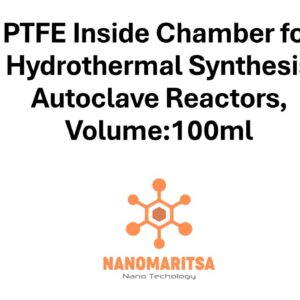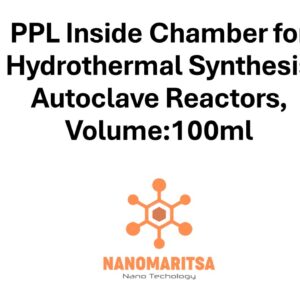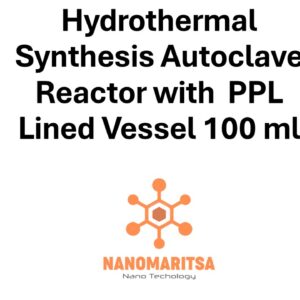PPL Inside Chamber for Hydrothermal Synthesis Autoclave Reactors, Volume:50ml
€160.00
ComparePPL Inside Chamber for Hydrothermal Synthesis Autoclave Reactors (50 ml) is a critical component of hydrothermal synthesis autoclave reactors. It is a chamber made from Polyphenylene Sulfide (PPL), which is designed to withstand the high-pressure and high-temperature conditions required for hydrothermal reactions. This chamber is used for carrying out chemical reactions that involve the synthesis of nanomaterials, crystals, and other materials under controlled environments. Here’s an overview of the key features, properties, applications, and safety considerations of the PPL inside chamber for a 50 ml hydrothermal synthesis autoclave reactor:
1. Key Features:
- PPL Lining: The chamber is made from Polyphenylene Sulfide (PPL), a high-performance polymer known for its excellent resistance to a wide range of chemicals, including acids, bases, and solvents. This ensures that the chamber will not react with the chemicals used in the synthesis process, allowing for a pure and uncontaminated reaction.
- Volume (50 ml): The chamber has a 50 milliliter (ml) capacity, which is ideal for small-scale laboratory experiments. It provides enough volume for conducting controlled hydrothermal synthesis reactions while ensuring efficient use of reagents and materials.
- High-Pressure and High-Temperature Resistance: The PPL chamber can withstand the extreme pressure (up to 200-300 bar) and high temperatures (150°C to 250°C) typically required for hydrothermal synthesis reactions. This makes it suitable for a variety of material synthesis processes that rely on these conditions.
- Sealed Environment: The chamber is sealed inside the reactor to maintain a stable and controlled environment, ensuring that the temperature and pressure are consistently maintained throughout the reaction.
2. Properties:
- Chemical Resistance: The PPL material offers outstanding chemical resistance, preventing the chamber from reacting with corrosive substances or aggressive solvents inside the reactor. This guarantees that the synthesized materials remain uncontaminated and pure.
- Thermal Stability: PPL has excellent thermal stability and can withstand high temperatures (up to 250°C) without degradation, ensuring that the chamber can handle the elevated temperatures required in hydrothermal synthesis processes.
- Mechanical Strength: PPL is known for its mechanical strength, which helps the chamber maintain its structural integrity under the high-pressure conditions of the hydrothermal reactor.
- Non-reactivity: The PPL lining is non-reactive with most chemicals, ensuring that the material inside the chamber remains unaffected by the container material, which is crucial for maintaining the purity of the synthesized products.
3. Applications:
- Nanomaterial Synthesis: The PPL-lined chamber is commonly used for synthesizing nanoparticles, nanowires, and other nanostructures. The high-pressure and high-temperature conditions inside the chamber allow for the formation of nanomaterials with specific properties, such as high surface area or unique electronic characteristics.
- Crystal Growth: Hydrothermal synthesis is an effective method for growing high-quality crystals, including metal oxides, semiconductors, and other inorganic compounds. The chamber’s controlled environment helps achieve uniform growth of crystals, which is critical for their performance in various applications.
- Catalyst Synthesis: The chamber can be used for the synthesis of new catalytic materials or for modifying existing catalysts. The high-temperature and high-pressure conditions inside the chamber promote the formation of catalysts with enhanced efficiency and selectivity.
- Energy Materials: The chamber is also used to synthesize materials for energy storage devices, such as electrodes for batteries and supercapacitors, as well as materials for fuel cells. These materials benefit from the precise control over the reaction environment provided by the PPL-lined chamber.
- Environmental Applications: The chamber can be utilized to create materials for environmental applications, such as catalysts for pollution control, water purification, and materials for waste treatment and recycling.
4. Handling and Safety:
- Toxicity and Corrosiveness: While PPL is resistant to many chemicals, the substances used in hydrothermal synthesis can still be toxic, corrosive, or reactive. Proper safety precautions should be followed when handling chemicals inside the chamber to prevent exposure to hazardous materials.
- High-Pressure and High-Temperature Safety: The chamber operates under extreme conditions of pressure and temperature, so safety is paramount. It is essential to check the integrity of the chamber and reactor before each use and to follow proper operating procedures to ensure safe handling.
- Storage: After use, the PPL chamber should be cleaned thoroughly to remove any residual chemicals. It should be stored in a cool, dry place to prevent damage to the material and to preserve the chamber’s effectiveness for future use.
- Precautions: Always wear appropriate personal protective equipment (PPE), such as gloves, goggles, and lab coats, when handling the hydrothermal synthesis reactor. It is important to work in a well-ventilated area or under a fume hood when using potentially hazardous chemicals.
Summary:
The PPL Inside Chamber for Hydrothermal Synthesis Autoclave Reactors (50 ml) is a vital component for conducting controlled hydrothermal reactions in laboratory settings. Its PPL lining offers excellent chemical resistance, thermal stability, and mechanical strength, making it suitable for high-pressure and high-temperature synthesis of various materials, such as nanomaterials, crystals, and catalysts. The 50 ml volume is ideal for small-scale experiments, allowing for efficient use of materials while maintaining precise control over the reaction environment. Whether used for research or material development, the PPL-lined chamber is an indispensable tool in advanced material synthesis.
| Pieces | 1 Piece, 5 Pieces |
|---|






